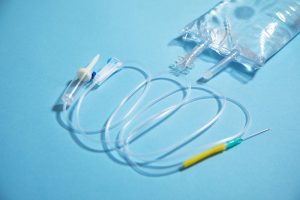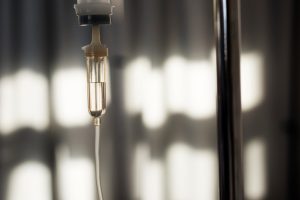The human body is a meticulously balanced ecosystem where every fluid and electrolyte level must be maintained within a precise range for optimal function. As IV therapy becomes more and more popular, you may be wondering how different IV solutions interact with one’s body. Among the array of medical interventions, isotonic IV solutions stand as a vital tool, seamlessly integrating with the body’s delicate equilibrium. But what are isotonic IV solutions exactly? Do they help with dehydration, and are they used after surgery?
Join us as we dive into the meticulous science behind their formulation, the rigorous safety protocols that govern their use, and the countless lives they have impacted across the globe.
What Are Isotonic IV Solutions?
Isotonic IV solutions are fluids with the same salt and mineral concentration as blood. They’re administered directly into a vein to restore fluids and nutrients in the body. These solutions are commonly used in medical settings.
They are vital for patients unable to drink fluids or requiring rapid hydration. By matching the body’s natural balance, isotonic IV solutions help maintain proper hydration levels and support various medical treatments, making them essential in healthcare for replenishing lost fluids and maintaining bodily functions.

How Do Isotonic IV Solutions Work?
Isotonic IV solutions are specially formulated fluids designed to have a balanced concentration of dissolved particles. These fluids precisely match the osmolarity of bodily fluids like blood plasma. This allows them to seamlessly integrate into the bloodstream.
They facilitate optimal rehydration without disrupting the delicate fluid balance within cells. When an IV fluid is isotonic, its osmolarity matches the body’s natural levels, preventing dangerous alterations in cell volume caused by excessive fluid shifts.
Isotonic solutions mimic the osmolarity of the blood, enabling them to rehydrate effectively and maintain proper electrolyte balance. Their unique ability to match the body’s osmolarity is key to enabling safe, efficient fluid replenishment and electrolyte restoration.
Potential Benefits of Isotonic IV Solutions
A key advantage of isotonic IV solutions is their rapid absorption into the bloodstream. With a balanced particle concentration matching bodily fluids, these solutions face no resistance crossing cell membranes.
This allows for efficient, streamlined uptake and enables faster rehydration and electrolyte replenishment compared to non-isotonic fluids. Their precise osmolarity prevents excessive swelling or shrinking of cells from fluid shifts, minimizing the risk of cellular damage during administration.
Furthermore, isotonic solutions play a crucial role in maintaining the body’s physiological equilibrium or homeostasis. By aligning with the body’s natural osmolarity levels, they integrate seamlessly, rehydrating effectively without disrupting the intricate processes that regulate internal balance.
This stability helps minimize strain on regulatory systems as the body focuses on healing rather than compensating for imbalances. The osmolarity matching of isotonic fluids ultimately helps uphold this delicate equilibrium.
Common Isotonic IV Solutions
Normal saline is one of the most widely used isotonic IV fluids. Its simple composition of sodium chloride dissolved in water at a concentration matching human blood plasma allows it to be versatile.
Normal saline is commonly used for fluid replacement, rehydration, and replenishing sodium levels in cases like dehydration and hypovolemia. While effective, it lacks other essential electrolytes beyond sodium and chloride, making it unsuitable as a total body fluid replacement in certain scenarios.
Lactated Ringer’s Solution for Electrolyte Replenishment
For more comprehensive electrolyte replenishment, lactated Ringer’s solution is often preferred. Its balanced electrolyte profile, including sodium, potassium, calcium, and lactate, closely resembles the blood plasma.
This allows lactated Ringer’s solution to be used for fluid/electrolyte replacement. It can also help correct electrolyte imbalances. Lactated Ringer’s solution can aid in treating metabolic acidosis by supporting various bodily processes.
Compared to normal saline, its broader electrolyte mix makes it suitable for more comprehensive replacement therapy. However, its specific composition requires caution. Lactated Ringer’s solution should be used with care in some clinical conditions.
When Should Isotonic Solution Be Given?
Isotonic IV solutions are primarily indicated for fluid and electrolyte replacement therapy. They are used in cases of dehydration caused by illnesses, injuries, or excessive fluid loss. They help rehydrate the body and restore electrolyte balance. But when to give isotonic solutions?
Isotonic solutions are also commonly used during surgical procedures to maintain proper hydration and electrolyte levels, supporting essential bodily functions. Certain patient populations, like children and the elderly, are particularly vulnerable to fluid imbalances and may require isotonic IVs for prompt rehydration.
In many scenarios, isotonic solutions are the preferred choice over other IV fluid types. Their balanced particle concentration allows rapid absorption into the bloodstream, facilitating faster rehydration.
Their osmolarity matches bodily fluids, minimizing cellular disruption by preventing excessive fluid shifts into or out of cells during administration. This protects against potential cellular damage or complications, making isotonic IVs a safer option for IV therapy across various medical situations and patient populations.

Conclusion
This article has provided a comprehensive exploration of the unique properties and importance of isotonic IV solutions, as well as what are isotonic IV solutions. By examining the scientific principles behind isotonicity and the precise balance of solutes and solvents, you now understand what sets these solutions apart.
These specialized fluids facilitate optimal fluid exchange within the body’s complex systems. You can now appreciate their significance in modern healthcare and the vital role they play in promoting patient well-being.



